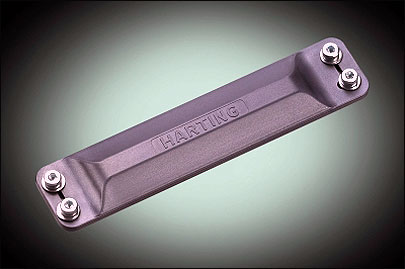Switzerland’s Harting Mitronics, which designs and produces multifunctional packaging, has launched a passive UHF (868 MHz) transponder with a three-dimensional antenna that provides the tag a read range of up to 5 meters (16 feet). The company claims this range applies even in the presence of liquids or metal.
At the time of the product’s launch in late April, Harting Mitronics won the 2006 Hermes Award, an international prize with a 100,000-euro purse, overseen and awarded by the Hanover technology trade fair. The transponders feature unlimited service life and high-protection versions for applications in extreme environments, such as high temperatures or vibrations, the company reports.
The tags are made with Atmel‘s ATA5590 chips, which have 1 kilobit of read-write memory and come housed in a shock-resistant thermoplastic casing that resembles a small chocolate bar and measures 135 by 30 by 8 millimeters. The interior of the tag’s injection-molded housing has been given a laser-structured metal coating to create a three-dimensional conductive structure that works as an inverted-F antenna and is assembled with an RFID chip. The tags use Atmel’s proprietary Tagidu air-interface protocol, and therefore can be used only with select readers, such as those made by Harting, Deister Electronic, Hoeft & Wessel and Idesco.
“I have not seen a product that combines robustness, heat resistance, a small size, a long reading distance and the ability to read around metals or fluids,” says Joerg Hehlgans, head of marketing and sales for Harting Mitronics, who adds, “We have seen similar products that are larger, but they are not hermetically sealed and do not have a high temperature range.” The casing’s hermetic seal allows the chip to be used outside in heat, snow or ice. This means the tag can be painted and used in environments where chemicals are being processed.
The transponders were developed for a specific customer, who wishes to remain unnamed, after a small systems integrator suggested the product be designed to tap the market for UHF transponders in industrial production and transport logistics.

Most companies working in industrial logistics use active transponders to track containers or metal pallets, says Hehlgans, but these can be large and expensive. A version of the tag that works within a standard temperature range of -40 to 85 degrees Celsius will sell for around 7 euros in small quantities, such as 100 units, or for 5 euros for 50,000 or other large quantities. A higher-end version able to withstand temperatures from -40 to 180 degrees Celsius will reportedly cost less than 10 euros in small quantities, and about 6 euros for larger orders.
The full product family is still under development, and the company has secured some protection by registering its design with German patent authorities.
Since the launch of the product at the Hanover Fair—one of the world’s largest industrial and technology expositions, attended this year by 5,175 exhibitors from 67 countries—Harting has received requests for information and given out samples to end users large and small, in such sectors as food services, medicine, computing and cars. Hehlgans expects the first orders from system integrators and distributors by the end of June. The full product family is expected to be available by the third quarter and will be produced in the company’s factory in Biel.


